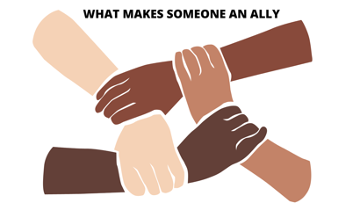28 Being an Ally
Read time: 1 minute
Overview
While organizations work towards bringing policies that foster EDI at the workplace, individuals like us can be allies and take measures to make the workplace more accommodating or welcoming. As many of us have some form of privilege, we can take advantage of our influence, and be allies for each other leading to a wider cultural shift. This chapter highlights practices one can implement to being an ally and contributing your part to your organization’s long term EDI goals.

- Holding yourselves and others accountable,
- Challenging your own assumptions and unconscious biases. Unconscious bias is our tendency to give certain people preference based on the patterns we have been conditioned with. It includes gender bias, cultural bias, age bias, race bias, and language bias. Since unconscious biases occur without one’s knowledge, control and intention, it is important to identify your own biases to act on them. To further learn about your own biases, refer to CIHR bias training here,
- Using language effectively in communications, for example, avoiding gendered language in writing, using pronouns correctly during conversations,
- Ensuring underrepresented groups have their ideas heard and included in teams,
- Engaging in direct conversations about EDI to break down silos and communication barriers,
- Make a conscious effort to hear every team member’s input in full,
- Giving the credit to originator when you hear a great idea without overlooking it if it comes from a minority group,
- Welcoming criticism if you are called out for discriminatory behavior or intervening if you see others exhibiting discriminatory behavior,
- Providing opportunities, encouraging minority groups to participate.
In conclusion, being an ally is partly about working on your own biases, partly about helping others address theirs and partly about supporting diverse groups into the spotlight.

